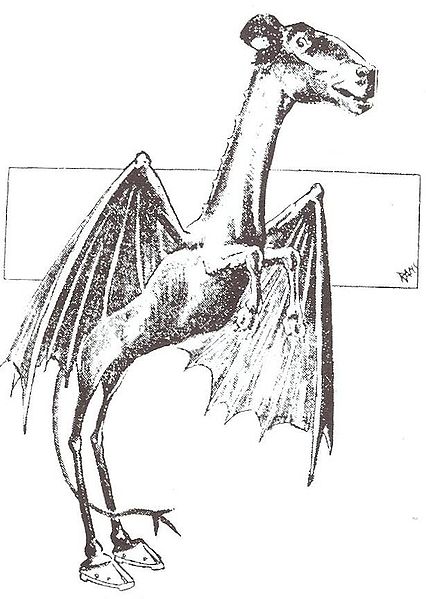Jersey Devil: Impossible Animal of Story & Legend

A devil is said to haunt the wooded Pine Barren of southern New Jersey. Dubbed the Jersey Devil, it has never been photographed or captured, but has appeared in dozens of books, films, and television shows including "The X-Files."
Most accounts suggest that the creature has a horse-like face with antlers or horns sprouting from the top of its head. It walks on two legs, ending with cloven hooves or pig's feet. The overall body shape resembles a kangaroo, though it also has wings like a bat. Some say it has a tail like a lizard; others say it has no tail at all. The monster is said to kill dogs, chickens and other small animals, as well as leave spooky cloven hoof prints in snow, and bellow a terrifying screech in the wooded darkness.
History of the Jersey Devil
The Jersey Devil is the subject of a legend dating from the early 18th century. There are several variations, but a common story holds that a woman named Mother Leeds (who was believed to have been the wife of a Daniel Leeds) gave birth to her 13th child on a dark and stormy night. Rumors claimed that she was a witch, and bore the Devil's child. Shortly after birth, it changed form, growing wings, hooves and an equine head. It flew into the air with a bloodcurdling shriek, killing a midwife in the process, and headed toward the woods.
It sounds like a scene from a horror film or novel, too bizarre to be true. And indeed Brian Dunning of the Skeptoid podcast notes that there are holes in the popular story of the Jersey Devil: "In looking at the historical sources, we soon find that this story is not possible. ... There appears to be no contemporary sources connecting Daniel Leeds or either of his wives to a devilish character of any sort, and ... Although newspapers of the 1800s did occasionally print the Mother Leeds story as given in the legend, we seem to have a total lack of factual basis to anchor it to any real history."
Despite its origins in legend, several people have claimed to have seen or encountered the Jersey Devil over the past 250 years. In a section on the topic in the encyclopedia "American Folklore," folklorist Angus Kress Gillespie notes that "The Jersey Devil remained an obscure regional legend through most of the eighteenth and nineteenth centuries, until 1909 when a series of purported 'Devil' sightings inspired a Philadelphia businessman to stage a hoax. He painted a kangaroo green, attached fake wings to the helpless creature, and had it exhibited to the public." The 1909 hoax (and others like it) inspired further sightings and reports, which continue to this day.
What Is the Jersey Devil?
Could the creature be real? The Jersey Devil's diverse features are strong evidence that it does not — and cannot — exist as a real animal. The most obvious biologically implausible feature is its wings: they would need to be much bigger, and anchored in a much more massive musculoskeletal structure, to lift the animal's body weight into the air. Birds and bats can fly because their bodies are relatively lightweight; the reputed heavy muscles and thick limbs of the Jersey Devil would never work; you'd have better luck putting butterfly wings on a rhino. Most images of the Jersey Devil look like a monster that a high school Dungeons & Dragons player might dream up as a composite of different, unrelated animals whose features could never actually exist in the same animal, but look weird and scary.
So what's the explanation for the Jersey Devil? There's very little to "explain"; we have a monster whose origin is obviously rooted in myth, and whose features are anatomically impossible. Many of the sightings and reports were hoaxes, though at least some of the eyewitnesses really believed they saw something. It is a mistake to look for one specific root cause for all the Jersey Devil reports; after all, descriptions (often at night in the deep woods) vary dramatically. Eyewitnesses who described huge wings may have seen sandhill cranes (which can stand four feet tall and have an enormous wingspan), while others who reported antlers may have seen something with antlers.
In their book "Monsters of New Jersey: Mysterious Creatures in the Garden State," Loren Coleman and Bruce Hallenbeck point out that "Not everything that gets shoved under the Jersey Devil banner really belongs there. Like other states, New Jersey harbors more than one mystery animal, but whenever one appears, inevitably it gets hailed ... as the latest manifestation of the Devil and so joins the great body of myth, legend, and lore."
The cultural context is important; any time people are brought up with stories and legends of local mysterious creatures or monsters — even if they don't believe them — it provides a template upon which to interpret anything strange or unusual. The same process happens in places like Scotland's Loch Ness, where floating logs or large fish that might be considered unremarkable and mundane in other lakes might be reported as a Loch Ness Monster sighting simply because the monster said to dwell there is so well known. [Video: Haunted House in New Jersey?]
The Jersey Devil is clearly a product of folklore and legend, but that doesn't mean that, late at night in the Pine Barrens forest, people might not see or sense it — just as they did centuries ago.
Benjamin Radford is deputy editor of Skeptical Inquirer science magazine and author of six books, including "Tracking the Chupacabra: The Vampire Beast in Fact, Fiction, and Folklore" and "Scientific Paranormal Investigation: How to Solve Unexplained Mysteries." His website is www.BenjaminRadford.com.
Related:
Sign up for the Live Science daily newsletter now
Get the world’s most fascinating discoveries delivered straight to your inbox.











